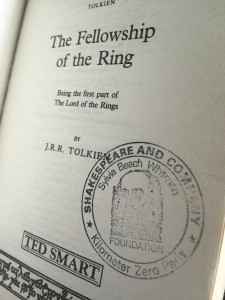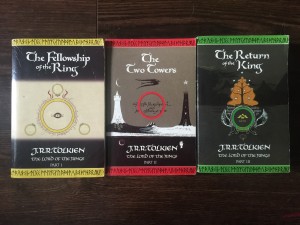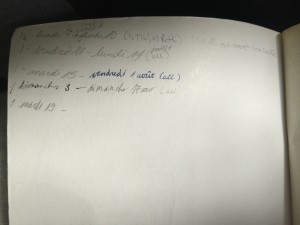Background
I am an avid fan of J.R.R. Tolkien’s The Lord of the Rings. I first read the books in either late elementary school or early middle school in the early 90s and then on and off again throughout high school, but ended up doing my most intense consumption of them during the summer of 2003. I was studying abroad in Paris in the time before tablets and e-readers. I could only bring two suitcases with me to France from the United States and so I opted against bringing any books with me. I was determined to only speak and read in French for the duration of my visit; I figured I could pick up a couple of novels while I was there or borrow from the library. I quickly discovered that, despite being fluent in French, I sometimes wanted to read in my native language. I did not have a lot of money for frivolous purchases, so I decided to buy a handful of books that were long and could last me a good amount of time. I ended up at the famous store, Shakespeare & Co., whose doors face the magnificent Notre-Dame de Paris.
I ended up these copies of LotR:
I devoured them. This was between the cinematic releases of The Two Towers and Return of the King. I had seen Fellowship of the Ring and The Two Towers on their opening days and reread the books one time ahead of the first movie. The books were long and wonderful and appealed to me, between my love of history and languages and my need for an escape from the hottest summer on record in Europe, which killed 50,000 people. I read the books at least five times in six weeks.
Here’s the thing: the books are not for everyone. They are long, the language is often archaic, and the story meanders heavily at the beginning. It is wholly difficult to read if you regularly read authors whose editors have a heavy hand (hint: pretty much all modern literature). I know so many people who have said they have tried multiple times to read LotR and get bogged down in Fellowship. Almost everyone seems to get lost in the Old Forest on the borders of Buckland.
I’ll tell you a secret: as an avid reader of LotR and huge fan of Tolkien’s works… I skip huge chunks of LotR on most of my rereads. Every three or four times through, I’ll decide I’m going to read the entirety of a section I usually skip. I’ll read it, enjoy it, feel refreshed in my memory of it, and then promptly pop right over it the next time I read the books. I have had multiple people ask me to share my method of reading, so I am finally going to do it.
What is the Starlight Fellowship?
As cool as the name sounds, it is not a secret group of astronomers who plan to destroy all skyglow from artificial sources, nor is it anything occult. The Starlight Fellowship shamelessly lifts its name from the Machete Order, which is a fantastic way of watching the Star Wars movies (IV, V, II, III, VI, if you’re interested!). The Starlight Fellowship is simply a guide to reading The Fellowship of the Ring — telling you what chapters and sections to skip so that the story keeps moving. I have cut about 15% (50 pages out of 375) of The Fellowship of the Ring. I am not currently planning on writing up The Two Towers or Return of the King because the bits you should skip are pretty minimal there; there’s a lot less poetry and singing and what is there is not generally intrusive.
The language is deliberately archaic, which can be difficult to get used to. Some folks never do. If you are having trouble with the archaic language and own an e-reader, I recommend trying to read the books on there and utilize the built-in dictionary. The books require you to adjust to the language; about the time you start to get used to it, Fellowship goes into the chapters I cut. This is why most people give up.
Since everyone’s copies of the books are different, I use chapters and section guides.
Each chapter title is colored thus: red for “skip it,” green for “read it,” amber for “read most of the chapter and see notes for what to skip,” and blue for reader’s choice. If a chapter is in red, I include notes on whether you should come back and read it later. If you are colorblind, please note that I have tagged each chapter [r] [g] [a] and [b].
Fellowship of the Ring:
Note on the Text [r]
- Exactly what it sounds like – a bit of interesting background on the publication information and history of the text. It is very skippable.
Foreword [r]
- Interesting notes directly from Tolkien and his musings on the edition. Read at your own leisure/level of interest after you finish the books.
Prologue [b]
- This sets you up with all the information you need to know about Hobbits and the Shire. If you opt to skip it: know that hobbits live in clever holes in the ground and the Shire is about the size of Costa Rica and intermittently populated. They like to eat, drink, garden, and enjoy smoking pipe-weed. Hobbits are also keen on genealogy. The Shire itself is lush and green — imagine England.
Book 1
A Long-expected Party [g]
The Shadow of the Past [g]
Three is Company [g]
A Short Cut to Mushrooms [g]
A Conspiracy Unmasked [g]
The Old Forest [r]
- Things to know: they get lost in the Old Forest and meet Tom Bombadil. Tom Bombadil is a much-beloved character in the series, but Peter Jackson had the right of it: he does not advance the story. He merely adds depth to the lore of the Ring. I recommend coming back and reading these three red chapters at a later date; they are interesting and obviously intended to be part of the story.
In the House of Tom Bombadil [r]
- Things to know: Tom Bombadil is older than much of the world and the Ring seems to have no effect on him (he doesn’t turn invisible nor does he seem to desire it). His wife, Goldberry, is a delight. Come back and read at a later date.
Fog on the Barrow-downs [r]
- The hobbits end up in barrows, held by wights, but Tom Bombadil saves them and gives them each knives from the barrows for their use. Come back and read at a later date. All the wanderings basically lead up to the hobbits getting their swords. The movie effectively covers this with a single line from Aragorn to the Hobbits on Weathertop: “These are for you.” Skipping these three chapters basically cuts out 40 pages.
At the Sign of the Prancing Pony [g]
Strider [g]
A Knife in the Dark [a]
- There is a bit of singing in the middle when Aragorn talks about Lúthien and Beren. The song and the explanation take up three pages and you can skim these. When you get to, “As Strider was speaking they watched his strange, eager face” you can pick back up. Good to know: the story of Lúthien and Beren basically parallels Arwen and Aragorn.
Flight to the Ford [g]
Book 2
Many Meetings [a]
- Read it, BUT there is a LOT of singing. They’re mostly histories, but not strictly necessary for the story. Basically: if it’s in italics, you can skip it. (Come back and read it later, if you’re so inclined.)
The Council of Elrond [g]
- So there are many complaints about how long the Council of Elrond is. It’s about 30 pages in my book and 100% exposition. Lots of people taking turns talking. It is a critical chapter and actually broken up into smaller stories, as a half-dozen people take their turns talking about what brought them to Rivendell and their involvement with Sauron or the Ring.
The Ring goes South [a]
- Read it. Be aware that some find the climb up Caradhras extraneous. (They go up and get their path blocked by Saruman’s sorcery, so they decide to turn around.) If you decide to skip Caradhras, it’s at the end of the chapter, so you can jump straight to A Journey in the Dark.
A Journey in the Dark [a]
- There’s a bit of poetry about Moria in the middle; it’s an easy read but feel free to skip it.
The Bridge of Khazad-dûm [g]
Lothlórien [a]
- Legolas has a bit of song in the middle. It’s an easy read, but once again, we fall into the “if it’s in italics, feel free to skip it” area.
The Mirror of Galadriel [g]
- Don’t skip Frodo’s poem, or Sam’s addition; it’s short and a thoughtful eulogy.
Farewell to Lórien [g]
- Bits of poetry here and there; okay to skip them.
The Great River [g]
The Breaking of the Fellowship [g]
There you have it! That is the Starlight Fellowship. I’m sure some fans will have strong opinions on me cutting Tom Bombadil from the story, just as they did for Peter Jackson. Please keep in mind I’m not saying to never read Tom Bombadil’s chapters; just that there’s no need to read them right now.
If this helped you read The Lord of the Rings trilogy when you hadn’t managed before, please let me know! Did you go back and read the parts you initially skipped? What did you think? And if it didn’t work for you or you didn’t enjoy the books, that is okay, too. No one is obligated to like all parts of geek culture. You can keep on enjoying what you do enjoy!



